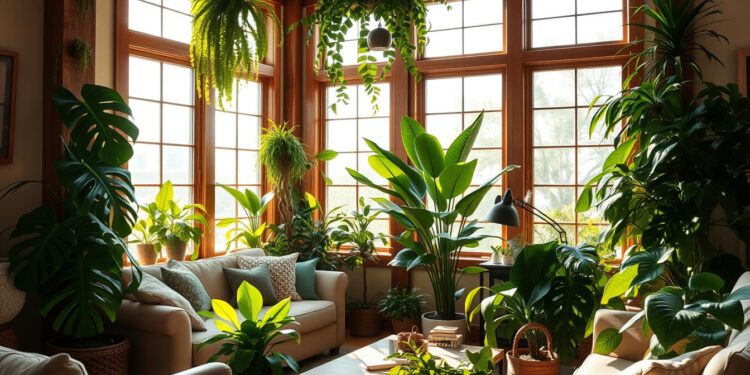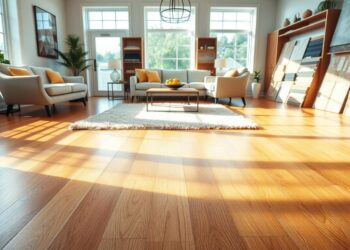Living room plants do more than just look good; they bring life to your space. Adding greenery can turn a dull area into a lively oasis. These plants not only make your space look better but also help clean the air and lift your mood.
By picking the right plants, you can make your home feel welcoming. It shows off your style and improves your emotional health.
Key Takeaways
- Living room plants improve indoor air quality.
- Indoor plant decor adds warmth and vibrancy.
- There are many houseplants suitable for small spaces.
- Greenery can boost your mood and enhance well-being.
- Choosing the right plants reflects your personal style.
Benefits of Having Living Room Plants

Adding plants to your living room is more than just decoration. They offer many practical benefits that make your home better. They improve air quality and even lift your mood, making your home more welcoming.
Improve Indoor Air Quality
Plants are key in making indoor air cleaner. They remove harmful toxins and pollutants, making your home healthier. The Peace Lily and Spider Plant are great for this, making them ideal for your living room.
Enhance Aesthetics
Plants also make your living room look better. They bring color, texture, and life to your space. Placing plants thoughtfully can highlight certain areas, adding warmth and charm. This greenery helps tie your decor together, creating a unified look.
Boost Your Mood
Having plants around can make you feel happier and less stressed. They create a calm and peaceful environment, improving your mental health. A few plants can change your living room into a cozy and enjoyable space.
Choosing the Right Plants for Your Living Room

Choosing the right plants can make your living room lively and welcoming. Think about the light and if they’re safe for pets. There are three main categories to find the perfect plants for your space.
Low-Light Plants
Don’t worry if your living room is dark. Some plants can grow well in low light. Here are a few:
- Snake Plant: Tolerates neglect and low light.
- ZZ Plant: Very low maintenance and can survive in dim spaces.
- Pothos: Adaptable and great for adding greenery to darker rooms.
Pet-Friendly Options
If you have pets, picking safe plants is key. You can enjoy plants without worrying about them being toxic. Here are some good options:
- Spider Plant: Non-toxic and easy to grow.
- Boston Fern: Adds lush foliage without risk to pets.
- Areca Palm: Safe for furry friends and a beautiful addition.
Statement Plants
For a standout feature, choose statement plants. They can be the highlight of your room:
- Fiddle Leaf Fig: Bold leaves that add drama to any room.
- Monstera: Iconic foliage that enhances the overall aesthetic.
- Bird of Paradise: Striking shape that brings an exotic touch.
Popular Living Room Plants

Choosing the right plants can turn your living room into a vibrant oasis. Plants that beautify and are easy to care for are in high demand. Below, you’ll find some of the most popular living room plants, perfect for any home.
Fiddle Leaf Fig
The Fiddle Leaf Fig is loved for its dramatic, large, glossy leaves. It can grow tall, making it a striking focal point. It’s also one of the best indoor plants because it thrives in bright, indirect light.
Snake Plant
The Snake Plant is great for small spaces. Its upright, sturdy leaves add a modern touch. It adapts well to different light conditions and purifies the air. This low-maintenance plant is perfect for forgetful waterers.
Pothos
Pothos is a versatile plant with trailing vines. It does well in hanging baskets or on shelves. It’s easy to care for, making it a favorite for beginners. Pothos is a great choice for adding greenery to your home.
Plant Care Tips for Beginners

Caring for indoor plants is rewarding. Beginners can make a big difference by following simple tips. Knowing the basics of watering, light, and fertilizing is key.
Watering Guidelines
Watering is vital for indoor plants. Most prefer the soil to dry a bit before watering again. Too much water can cause root rot, harming your plant. Here’s how to water right:
- Check the top inch of soil. If it’s dry, it’s time to water.
- Water thoroughly until you see drainage from the bottom of the pot.
- Keep in mind that plants need less water in winter.
Light Requirements
Plants have different light needs. Some do well in indirect light, while others need direct sunlight. Here’s what to consider:
- Put low-light plants, like snake plants and pothos, in shadier spots.
- For sun-loving plants, near south or west-facing windows is best.
- Watch your plants; if they lean towards the light, they need more.
Fertilizing Basics
During the growing season, a balanced fertilizer is crucial. Here are some fertilizing tips:
- Use a balanced fertilizer with equal parts nitrogen, phosphorus, and potassium.
- Apply during the active growing season, following package instructions.
- Stop fertilizing in the dormant winter months.
Creating a Plant Display

Bringing your indoor plant decor to life is all about arrangement and creativity. Use shelves and stands to show off plants of different heights and shapes. This adds depth and interest to your space. Grouping plants together makes them more beautiful and helps them thrive.
Shelves and Stands
Shelves and stands are great for plants, adding both function and style. Here are some tips for making your plant displays stand out:
- Choose a stand with multiple tiers to make the most of space.
- Vary plant heights to draw the eye upward.
- Use decorative pots that match your style.
Grouping Techniques
Grouping plants can turn your living area into a lush oasis. Mixing different sizes and types adds visual interest. Here are some effective grouping techniques:
- Mix textures, like a tall Snake Plant with cascading Pothos.
- Use odd numbers of plants for a more natural look.
- Choose color combinations that match your decor.
Design Styles That Incorporate Plants

Adding plants to your home makes it feel warmer and more welcoming. Each design style can highlight plants in its own way. This makes your space feel more inviting. Here’s how you can add greenery to different decor themes.
Modern Minimalist
Modern minimalist decor is all about simplicity. A single elegant plant can be a beautiful centerpiece. Choose plants like a fiddle leaf fig or a snake plant for this style.
They do well in structured environments. Use sleek pots in neutral colors to keep things clean and simple.
Bohemian Vibes
Bohemian decor is all about being eclectic. Mix different plants, textures, and sizes for a lush look. Use colorful pots and hanging planters to add depth.
This style is all about creativity. Don’t be afraid to try out new combinations.
Industrial Chic
Industrial chic combines metal and concrete with plants for a modern feel. Use metal stands or concrete pots for your plants. This style loves the contrast between hard and soft elements.
DIY Planters for Living Room

Making your own planters is a fun and green way to improve your living area. By using recycled materials, you turn old items into beautiful planters. These DIY planters show off your style and help make your home more eco-friendly. Upcycling gives new life to old things, making each project special and creative.
Recycled Materials
Many common items can become plant containers. Here are some ideas:
- Old tin cans: They can be painted and decorated for a rustic look.
- Wooden crates: These add character and can be stacked for varying heights.
- Plastic bottles: Cut them in half and use them for smaller plants.
- Cardboard boxes: Line them with a plastic bag and create drainage holes.
Upcycling Techniques
Upcycling adds a creative twist to making planters. Here are some techniques to try:
- Painting: Use non-toxic paint to personalize your containers.
- Decoupage: Add fabric or paper to create a unique design.
- Hanging planters: Use old belts or rope to suspend containers from hooks for a dramatic effect.
- Layering: Combine different materials, such as rocks and soil, to enhance drainage and aesthetics.
Seasonal Plant Choices

Adding seasonal plants to your living room makes it lively all year. Each season offers a chance to update your space with new colors. The right plants not only look good but also make your room feel welcoming.
Best Plants for Spring
Spring is a time of renewal, perfect for adding bright flowers. Here are some great options:
- Geraniums – These annuals shine with vibrant colors and do well in sunlight.
- Petunias – They come in many colors, adding a cheerful vibe to any room.
- Begonias – Their beautiful leaves and flowers do well in bright, indirect light.
Summer Favorites
Summer brings warm weather, ideal for tropical plants. Here are some favorites:
- Hibiscus – This plant has big flowers and loves bright light.
- Philodendrons – They have heart-shaped leaves and do well indoors.
- Bromeliads – Their unique shapes and colors add a fresh touch.
Fall and Winter Options
As days get shorter, choose plants that handle cooler weather. Here are some good choices:
- Christmas Cactus – Blooms in the holiday season, adding festive cheer.
- ZZ Plant – It’s great for low light and doesn’t need much water.
- Pothos – This plant does well in different light, making it perfect for any season.
| Season | Plant Examples | Light Requirements |
|---|---|---|
| Spring | Geraniums, Petunias, Begonias | Bright, indirect light |
| Summer | Hibiscus, Philodendrons, Bromeliads | Bright light |
| Fall/Winter | Christmas Cactus, ZZ Plant, Pothos | Low to moderate light |
Common Mistakes with Living Room Plants

Caring for indoor plants can be very rewarding. Yet, many people make common mistakes that harm their plants. Knowing these mistakes is key to keeping your plants healthy. Here are three mistakes to avoid for thriving plants.
Overwatering Issues
One big mistake is overwatering. Too much water can cause root rot, damaging your plants badly. Learn how much water each plant needs. Check the soil moisture before watering, only when it’s needed.
Incorrect Placement
Where you place your plants is very important. Make sure each plant gets the right amount of light. Some plants love bright, indirect sunlight, while others prefer low light. Direct sunlight can burn sensitive leaves.
Neglecting Pruning
Not pruning your plants can lead to dead leaves and slow growth. Pruning helps your plants grow new leaves and stay healthy. Regularly check your plants for dead leaves or stems to keep them looking good.
Fertilizers and Soil for Living Room Plants

Knowing about fertilizers and soil is key for your plants to grow well. The right fertilizers feed your plants, and good soil lets their roots grow. It’s all about finding the right balance for your plants.
Organic vs. Chemical Options
You can choose between organic and chemical fertilizers for your plants. Organic options like compost and manure make the soil better over time. They give nutrients slowly, helping plants grow without harming the soil.
Chemical fertilizers give plants a quick nutrient boost. They’re good for plants that need food fast but can harm the soil if used too much. Your choice depends on what you believe in gardening and the plants you have.
Choosing the Right Soil Mix
Finding the perfect soil mix is crucial for different plants. Here’s a simple guide:
| Plant Type | Soil Type |
|---|---|
| Succulents | Sandy, fast-draining soil |
| Tropical Plants | Moisture-retaining potting mix |
| Herbs | Well-draining, nutrient-rich soil |
| Flowering Plants | Balanced potting mix |
Knowing what your plants need helps you pick the best fertilizers and soil. A bit of knowledge can make a big difference in caring for your plants.
The Role of Plants in Home Décor

Plants play a big role in making your home look better. They add beauty and create a cozy feel. By using plants, you can change a room’s look, making it more balanced and peaceful. They also fit well with modern indoor plant trends.
Complementing Color Schemes
Think about how plant colors match your home’s decor. Here are some tips:
- Choose plants with bright leaves to add life to simple colors.
- Match plant flower colors with your decor for a smooth look.
- Use different greens to add depth and contrast to your furniture.
Balancing Space and Scale
It’s important to know your room’s size when adding plants. Here are some tips for placing plants:
- Use big floor plants, like Rubber Trees, in large rooms to stand out.
- Put small plants, like Peperomias, on shelves or tables in small spaces to keep things tidy.
- Place plants at different heights for a lively yet balanced look.
Feng Shui and Living Room Plants

Adding Feng Shui to your living room can make it feel more harmonious. The right plants are key to bringing in positive energy. Here are some plants that can uplift your space.
Plants for Positive Energy
- Jade Plant: Known for attracting good fortune and prosperity.
- Peace Lily: This plant symbolizes purity and peace, promoting serenity.
- Snake Plant: A symbol of protection and vitality, perfect for improving air quality.
- Lucky Bamboo: Often associated with good luck and strong energy flow.
Suggested Positions and Arrangements
Placing plants with Feng Shui in mind can boost their benefits. Here are some tips:
- Place plants near the entrance to attract wealth and well-being.
- Position them in the corners of the living room to enhance energy flow.
- Avoid clutter by keeping arrangements simple and balanced.
Indoor Gardening Tools You Need

To make your indoor gardening better, you need the right tools. These tools help you care for your plants more easily. Make sure you have the essentials to help your plants grow well.
Watering Cans
A good watering can is key for indoor gardeners. It stops spills and makes sure plants get the right amount of water. Choose one with a narrow spout for better control.
Pruning Shears
Pruning is important for plant health. Pruning shears help cut off dead leaves and encourage growth. Pick a pair that feels good in your hand for easy use.
Soil Moisture Meters
Knowing when to water is crucial for plants. Soil moisture meters let you check soil moisture. This tool helps you avoid watering too much or too little.
| Tool | Purpose | Features to Look for |
|---|---|---|
| Watering Can | Provides accurate watering | Narrow spout, comfortable handle |
| Pruning Shears | Trims dead or unhealthy growth | Ergonomic design, sharp blades |
| Soil Moisture Meter | Monitors soil moisture levels | Easy-to-read display, reliable sensors |
Incorporating Edibles in Your Living Room

Adding greenery to your home is both beautiful and practical. Growing edibles in your living room lets you have fresh herbs and veggies right there. It makes your home look better and gives you fresh ingredients for cooking.
Herbs for Small Spaces
Herbs are perfect for small indoor gardens. They grow well in small pots and need little care. Here are some great herbs for your living room:
- Rosemary: This fragrant herb loves bright light and is easy to trim for cooking.
- Basil: A favorite in many kitchens, basil thrives in warmth and adds a pop of green.
- Thyme: Thyme is low maintenance and drought-resistant, making it perfect for small containers.
- Parsley: This versatile herb does well indoors with the right light and water.
Indoor Vegetable Gardening
For a bigger challenge, try indoor vegetable gardening. Dwarf varieties grow well in small spaces. Here are some options:
- Dwarf Tomatoes: ‘Tiny Tim’ varieties produce plenty of fruit and fit well with houseplants.
- Mini Peppers: These colorful peppers brighten up your kitchen and add to your cooking fun.
- Salad Greens: Growing leafy greens like lettuce and spinach means you always have fresh salads ready.
Expert Tips for Successful Plant Growth
To make your living room plants thrive, you need to balance light, water, and nutrients. This balance is key for strong growth and health.
Finding the Right Balance
What’s best for your plants? Here are important things to think about:
- Light: Plants need different amounts of light. Make sure to match your space’s light with the right plants.
- Water: Don’t overwater by checking soil moisture first. Each plant has its own water needs based on type and season.
- Nutrients: Use fertilizers wisely to help growth without harm. Follow specific guidelines for your plants.
Regular Maintenance Routines
Regular care boosts your plants’ health. Here are some steps to follow:
- Pest Checks: Check your plants often for pests. Catching them early stops infestations.
- Leaf Cleaning: Dust on leaves can block photosynthesis. Clean leaves with a damp cloth to keep them healthy.
- Drainage Maintenance: Make sure pots drain well to prevent root rot. Check and adjust as needed.
- Schedule Care: Create a calendar for watering, fertilizing, and pruning. This keeps your indoor garden thriving.
Where to Shop for Living Room Plants
When looking for plants, local nurseries and online stores have their own benefits. Local nurseries let you see plants in person, ensuring they’re healthy. You can also get advice from experts who know what plants will do well in your home.
Online stores, on the other hand, offer convenience. You can look at many plants from home and find rare ones. But, always check reviews and return policies to ensure quality.
In conclusion, both local nurseries and online stores have their advantages. You can find the perfect plants for your living room by trying both. Your home will be beautiful, and your plants will be happy!
















